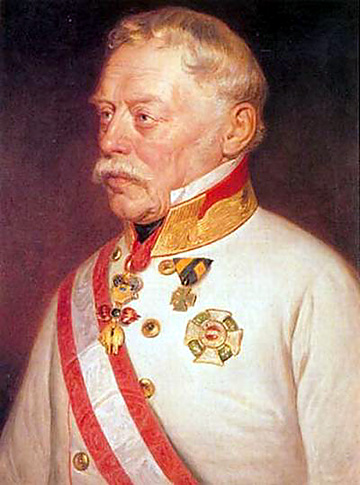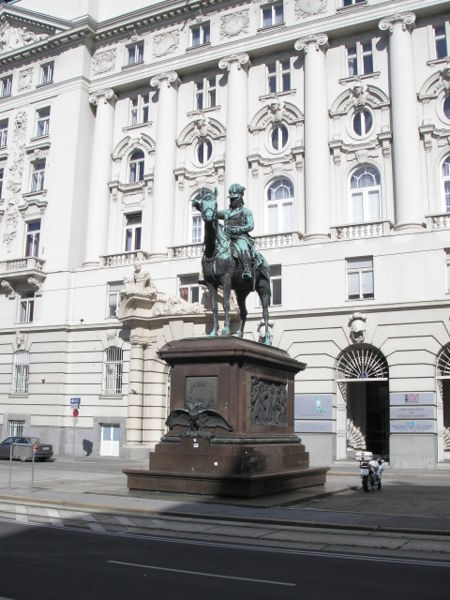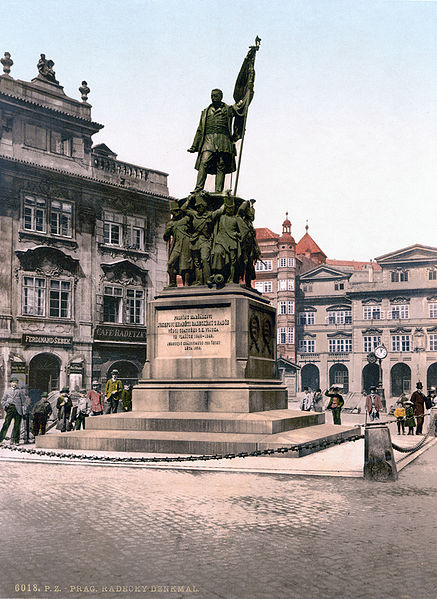<Back to Index>
- Mathematician George Boole, 1815
- Painter Jean Baptiste Siméon Chardin, 1699
- Field Marshal Johann Josef Wenzel Graf Radetzky von Radetz, 1766
PAGE SPONSOR



Johann Josef (Joseph) Wenzel (Anton Franz Karl) Graf Radetzky von Radetz (Schloss Trebnitz, Bohemia, November 2, 1766 – Milan, Italy, January 5, 1858) was a Czech nobleman and Austrian general, immortalised by Johann Strauss I's Radetzky March. General Radetzky was in the military for over 70 years, until his death at age 91, and is known for the victories at the Battles of Custoza (July 24–25, 1848) and Novara (March 23, 1849) during the First Italian War of Independence.
Radetzky was born into a noble family at Třebnice (Trebnitz) near Sedlčany in Bohemia (modern-day Czech Republic). Orphaned at an early age, he was educated by his grandfather, and after the count's death, at the Theresa Academy at Vienna. The academy was dissolved during his first year's residence in 1785, and Radetzky became a cadet in the Austrian Army. The following year he became an officer, and in 1787 was promoted to first lieutenant in a cuirassier regiment. He served as a galloper on Count von Lacy's staff in the Turkish War, and in the Austrian Netherlands from 1792 to 1795.
In 1798 he married Countess Francisca von Strassoldo Grafenberg, from Tržič. They would have five sons and three daughters. In 1795 Radetzky fought on the Rhine. Next year he served with Johann Beaulieu against Napoleon in Italy, but disliked the indecisive "cordon" system of warfare which Count von Lacy had instituted and other Austrian generals imitated. His personal courage was conspicuous. At the Battle of Fleurus (1794) he led a party of cavalry through the French lines to discover the fate of Charleroi, and at Valeggio sul Mincio in 1796, with a few hussars, he rescued Beaulieu from the enemy. Promoted to major, he took part in Dagobert Wurmser's Siege of Mantua campaign,
which ended in the fall of that fortress. As lieutenant-colonel and
colonel he displayed bravery and skill in the battles of Trebbia and Novi (1799). At the Battle of Marengo, as colonel on the staff of Melas,
he was hit by five bullets, after endeavouring on the previous evening
to bring about modifications in the plan suggested by the "scientific" Franz Zach. In 1801 Radetzky was created a Knight of the Military Order of Maria Theresa. In 1805, on the march to Ulm, he received news of his promotion to major-general and his assignment to a command in Italy under the Archduke Charles of Austria. He thus took part in the successful campaign of Caldiero.
Peace provided a short leisure, which he used in studying and teaching
the art of war. In 1809 he led a brigade in V Corps during the Battle of Eckmuhl. Promoted lieutenant field marshal, he commanded a division in IV Corps at the Battle of Wagram. In 1810 he was created a Commander of the Order of Maria Theresa and awarded the colonelcy of the 5th Radetzky Hussars.
From 1809 to 1812, as chief of the general staff, he was active in
reorganising the army and its tactical system, but unable to carry out
the reforms he desired owing to the opposition of the Treasury, he
resigned the position. In 1813 he was Schwarzenberg's chief of staff and had considerable influence on the councils of the Allied sovereigns and generals. Langenau,
the quartermaster-general of the Grand Army, found him an indispensable
assistant, and he had a considerable share in planning the Leipzig campaign. As a tactician he won praise in the battles of Brienne and Arcis sur Aube. He entered Paris with the allied sovereigns in March 1814, and returned with them to the Congress of Vienna, where he appears to have acted as an intermediary between Metternich and Tsar Alexander I of Russia, when the two were not on speaking terms. During
the succeeding years of peace he disappeared from public view. He
resumed his functions as chief of staff, but his ardent ideas for
reforming the army came to nothing in the face of the general
war-weariness and desire to "let well alone." His zeal added to the
number of his enemies, and in 1829, after he had been for twenty years
a lieutenant field marshal, it was proposed to place him on the retired
list. The emperor, unwilling to go so far as this, promoted him general
of cavalry and shelved him by making him governor of a fortress. But
very soon afterwards the Restoration settlement of Europe was shaken by
fresh upheavals, and Radetzky was brought into the field of war again.
He took part under Frimont in
the campaign against the Papal States insurgents, and succeeded that
general in the chief command of the Austrian army in Italy in 1834. In
1836 he became a field marshal. He was now seventy, but still displayed
the activity of youth in training and disciplining the army he
commanded. But here too he was in advance of his time, and the
government not only disregarded his suggestions and warnings but also
refused the money that would have enabled the finest army it possessed
to take the field at a moment's notice. Thus the events of 1848 in Italy,
which gave the old field marshal his place in history among the great
commanders, found him, in the beginning, not indeed unprepared but
seriously handicapped in the struggle with Charles Albert's army and the insurgents in Milan and elsewhere. By falling back to the Quadrilateral and
there, checking one opponent after another, he was able to spin out
time until reinforcements arrived, and thenceforward up to the final
triumph at the Battle of Novara on March 23, 1849, he and his army carried all before them. He also commanded the Austrian troops who reconquered Venice after the year-long siege of the rebellious city in May 1848 - August 1849. He became a Knight of the Order of the Golden Fleece in 1848. His
well-disciplined sense of duty to the superior officer had become more
intense in the long years of peace, and after keeping his army loyal in
the midst of the confusion of 1848, he made no attempt to play the part
of Wallenstein or even to assume Wellington's role of family adviser to the nation. While as a patriot he dreamed a
little of a united Germany, he remained to the end simply the commander
of one of the emperor's armies. After his triumph in Italy, he was made Viceroy of Lombardy-Venetia -
the first and last not of royal Habsburg blood. In spite of his success
against Italian patriots, he is not remembered unkindly even in Italy:
he was regarded as a fair ruler (for an enemy) and a gentleman who paid
his debts. There is also a memorable anecdote of his meeting the man
responsible for one of the most significant checks in the 1848
campaign, General Cesare Launier, shaking his hand, and congratulating
him on getting "a bunch of kids" (much of Launier's command was made up
of volunteer university students) to fight so hard that Radetzky and
his men seriously thought they were facing crack professional Sardinian
troops. Politically, he worked to reconcile especially the lower
classes to the Habsburg monarchy; he could see the Industrial
Revolution coming and hoped to use the conflict of classes to isolate
the patriotic party, made up mostly of the upper and middle classes,
from the rising working class. He was ruthless in punishing rebellious
soldiers - Hungarian troopers who had passed to the rebels' side in
1848 were not even shot, but hanged - and violent rebels, but very mild
with unarmed opponents: patriot leaders of European renown, such as Giuseppe Verdi, Alessandro Manzoni and Antonio Rosmini,
were allowed to live in peace in the kingdom, while Italy's other
reactionary governments drove all their liberals into exile. Already in
1849, at the end of the siege of Venice, he had allowed the local
patriot leaders to quietly slip away, and avoided public martyrdoms.
This was probably the best policy that Austria could possibly adopt in
the circumstances, but it was doomed anyway; the events of 1848-49 had
dug too deep a chasm between the Italians and the Austrian government,
and - as events in 1859 showed - it was only the power of Austrian arms
that kept Austria and her client states in Italy. It was part of
Radetzky's good fortune that he died one year before his whole work
dissolved like ice in an erupting volcano.
He died in harness, though in poor health. Josef Wenzel Graf Radetzky of Radetz died on January 5, 1858 after an accident in Milan. On January 19, 1858, he was buried in Heldenberg in Lower Austria. The Emperor wished that he be buried in the Capuchin crypt (the Imperial Crypt in Vienna).
Radetzky bequeathed his earthly remains, and the right to bury him, to
Joseph Gottfried Pargfrieder, whom decades earlier had settled his
debts. In Heldenberg is an open-air pantheon with warrior statues, the Gedenkstätte Heldenberg (literally translated as the Hero Mountain Memorial) Radetzky lies buried under a monumental obelisk.
In military history Radetzky's fame rests on one great achievement, but in
the history of the Austrian army he is the frank and kindly "Vater
Radetzky" whom the soldiers idolized. In the year following his death,
another and greater Italian war broke out, and his beloved army
disintegrated and was defeated in every encounter.